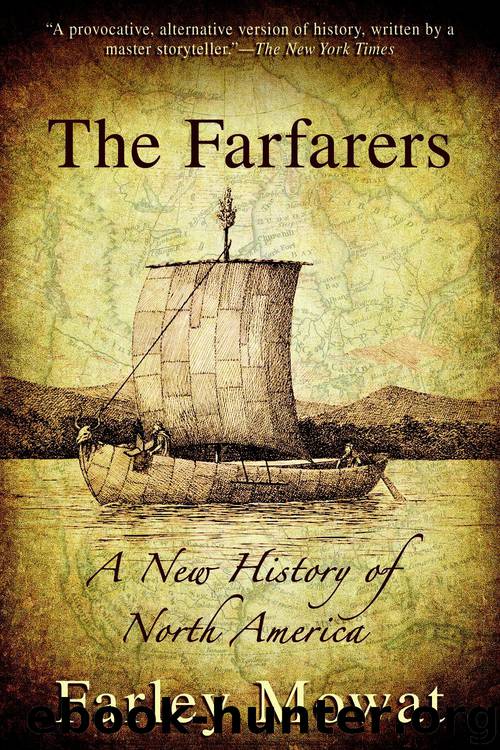The Farfarers by Farley Mowat

Author:Farley Mowat
Language: eng
Format: mobi, epub
Tags: Canada, Canadian, Archaeology, History
ISBN: 9781550139891
Publisher: Key Porter Books Ltd
Published: 1998-11-02T05:00:00+00:00
Late in the summer of 1982 Claire and I were guests aboard a Canadian ice breaker bringing an official party to Greenland to help commemorate the one thousandth anniversary of Erik Rauda’s arrival there.
I watched from the bridge as C.G.S. Pierre Radisson worked her way up Tunugdliarfik, longest of the Southfiords. It was still so choked with bergs and drift ice that even our modern ice breaker made slow progress. I had ample time to reflect on how the first European immigrants to this titans’ land might have felt about their future prospects.
Fifty miles in from the bleak outer coast the fiord divided. We took the left-hand fork, which led into a hidden world fringed by a rolling ribbon of meadows surrounded by lowering mountains.
Although the long passage up the fiord had been almost devoid of visible life, here at its head was a plethora of living things. Still waters reflected the double images of motionless bergs amongst which bobbed dozens of seals and a school of porpoises overflown by arabesques of gulls. However, it was on land that life manifested itself most prominently.
A dozen or so brightly painted wooden houses were scattered along the western shore. A flotilla of small boats lay hauled out on the beach in front of them. People of all ages were wandering about dressed in holiday splendour. The grassy slopes behind the houses were dotted with sheep; and here and there a pony raised its head to glance incuriously at the red-painted apparition which had just dropped anchor in the reach.
We went ashore to join in celebrations hosted by the local folk. Although most had Danish names they considered themselves to be of the same stock as Canada’s Inuit. They were not much impressed by the official fooferaw in honour of Erik the Red, but were very hospitable nonetheless.
Late that afternoon I asked a squat young man called Hans to show me the site of Erik Rauda’s home. Hans obligingly led the way across a squelching bog to what had been a beach in primordial times but now lay high and dry half a mile inland.
Brattahlid, as Erik called his steading, stood on this raised beach commanding an unobstructed view of the entrance to the inner reaches of the fiord. No ship, no boat, nothing above water could have approached without being seen by someone here. But at the time of our visit the only residents were three dyspeptic-looking sheep and a pair of snow buntings.
Not much remained visible of the homestead. After some five centuries of human habitation, Brattahlid had lain abandoned for another five, during which its stone-and-turf walls and sod roofs had subsided into shapeless mounds. These had been excavated in the 1930s by Danish archaeologists. The sod had now grown back, but the spades had revealed that, over the centuries of Norse occupancy, a number of rooms had been added to and around an original single-roomed structure.
It was this structure that especially interested me. Referred to in the archaeological literature
Download
This site does not store any files on its server. We only index and link to content provided by other sites. Please contact the content providers to delete copyright contents if any and email us, we'll remove relevant links or contents immediately.
| Civilization & Culture | Expeditions & Discoveries |
| Jewish | Maritime History & Piracy |
| Religious | Slavery & Emancipation |
| Women in History |
Cecilia; Or, Memoirs of an Heiress — Volume 1 by Fanny Burney(32434)
Cecilia; Or, Memoirs of an Heiress — Volume 2 by Fanny Burney(31868)
Cecilia; Or, Memoirs of an Heiress — Volume 3 by Fanny Burney(31852)
The Secret History by Donna Tartt(18840)
Sapiens: A Brief History of Humankind by Yuval Noah Harari(14244)
Leonardo da Vinci by Walter Isaacson(13179)
The Radium Girls by Kate Moore(11921)
Sapiens by Yuval Noah Harari(5293)
How Democracies Die by Steven Levitsky & Daniel Ziblatt(5127)
The Wind in My Hair by Masih Alinejad(5033)
Homo Deus: A Brief History of Tomorrow by Yuval Noah Harari(4820)
Endurance: Shackleton's Incredible Voyage by Alfred Lansing(4676)
The Silk Roads by Peter Frankopan(4456)
Man's Search for Meaning by Viktor Frankl(4419)
Millionaire: The Philanderer, Gambler, and Duelist Who Invented Modern Finance by Janet Gleeson(4374)
The Rape of Nanking by Iris Chang(4136)
Joan of Arc by Mary Gordon(4013)
The Motorcycle Diaries by Ernesto Che Guevara(4009)
Hitler in Los Angeles by Steven J. Ross(3900)
